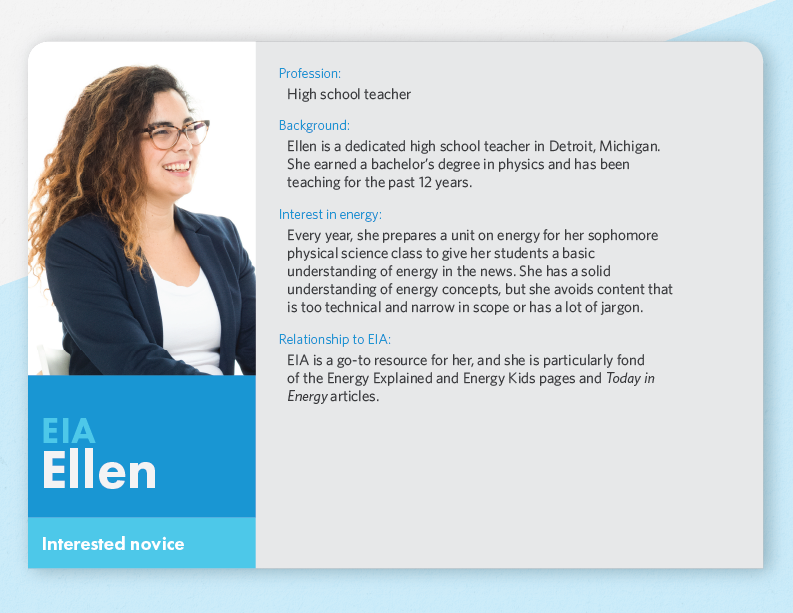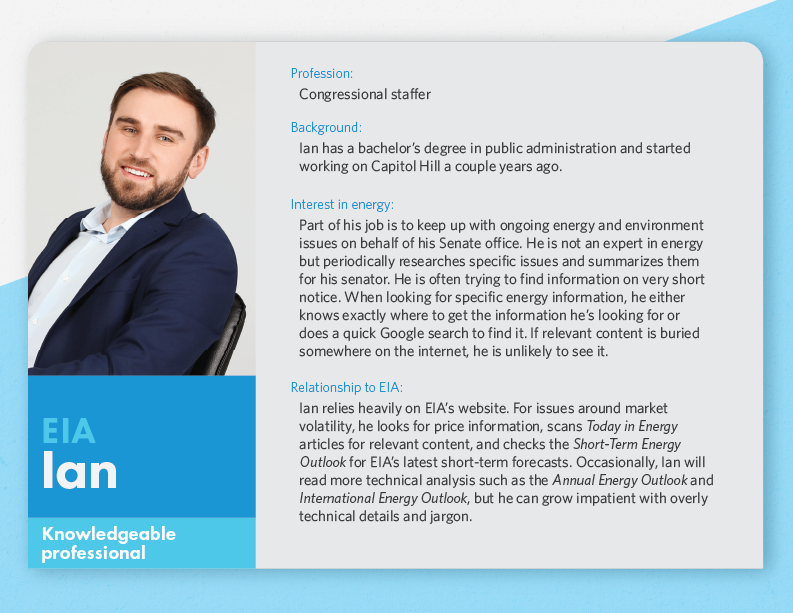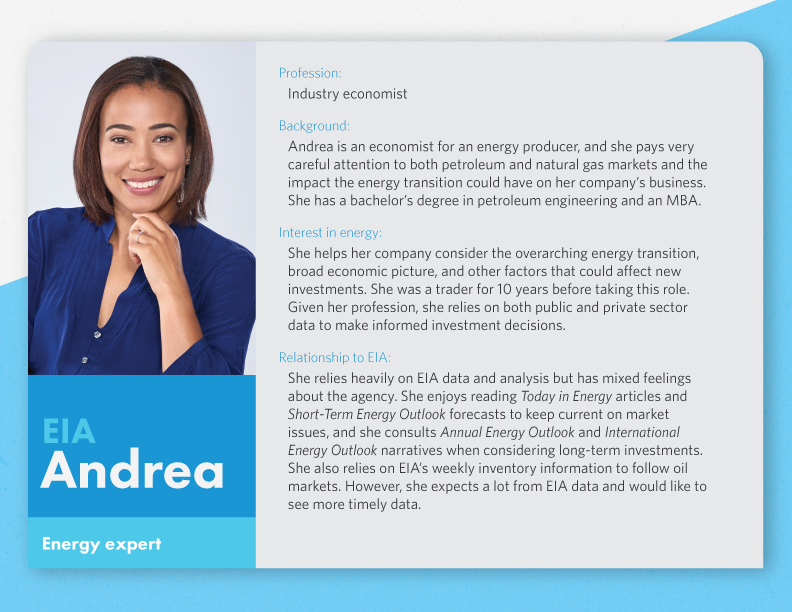Customer and Stakeholder Engagement at EIA
We have a broad range of customers and stakeholders, and we engage with them in a variety of ways. At least one quality is common to each of these relationships: We listen and are open to change. We want to continue to improve our ability to fulfill EIA's mission to promote sound policymaking, efficient markets, and public understanding of energy and its interaction with the economy and the environment.
Below are some examples of our interactions, meetings, surveys, and presentations to customers and stakeholders that help us collect feedback, get expert advice, and refine and improve our analysis and processes.
Outreach to external organizations
Through many different outreach avenues, we work with external stakeholders such as Congress, federal and state government, industry, associations and non-profits, and the media. Many EIA offices have regularly scheduled meetings with outside organizations, such as the International Energy Agency, the National Association of State Energy Officials, the International Association for Energy Economics, the World Energy Congress, the National Petroleum Council, the American Council for an Energy-Efficient Economy, and the National Association of Regulatory Utility Commissioners.
The American Statistical Association Advisory Committee
The American Statistical Association's (ASA) Committee on Energy Statistics provides technical advice to us at annual or semi-annual meetings. Sessions are a combination of EIA briefings and discussions intended to solicit technical advice from the committee members, who are primarily mathematical statisticians, survey statisticians, economists, and energy analysts. The committee is administered by the ASA, and the members are not required to reach consensus on their advice. Questions may be referred to eiainfostatisticalmethods@eia.gov.
Performing independent expert reviews
Since 1980, we have used the Independent Expert Review Program to seek technical reviews of its data and analytical work from outside subject matter experts as a way to guarantee high-quality products for our customers and data users. The reviews provide rigorous critiques and advice to EIA on: current and proposed data systems; energy forecasting models and modeling systems; energy forecasts; proposed analyses; and current and proposed publications. The reviewers provide written reports on their recommendations and meet with EIA staff to present, discuss, and defend their findings and proposed solutions.
We engaged the National Academy of Science's (NAS) Committee on National Statistics (CNSTAT) to convene a panel to conduct a comprehensive 30-month study of the Commercial Buildings Energy Consumption Survey (CBECS) and the Residential Energy Consumption Survey (RECS). The panel considered how we may improve data quality, geographic coverage, timeliness of data releases, and relevance of the data, as well as reviewed the survey design, frequency, scope, survey practice, and operations. A preliminary report was issued in spring 2010 that considered design and data collection options for the next CBECS.
The final report, published in February 2012, made recommendations for the design, conduct, and dissemination of CBECS and RECS information for the next decade and beyond, including the level of resources likely to be required. CNSTAT consulted with the National Academies' Board on Energy and Environmental Systems in preparing its report. In addition to its public workshops, which were arranged to gather insight from stakeholders and data users as well as from statistical experts, the panel commissioned research papers to inform its deliberations.
The Annual Energy Outlook and the National Energy Modeling System
One area of concentrated outreach is the dissemination of and customer feedback about the Annual Energy Outlook (AEO) generated using the National Energy Modeling System. The Annual Energy Outlook examines a variety of possible energy developments in the United States over the next 20–25 years. Outreach activities include:
- Early release of the AEO at a well-attended press conference where the Administrator of EIA presents the results and answers questions from the media and others in the audience
- Survey of major users of the AEO forecasts completed once per year, limited to 10 major users of the NEMS model
- Each modeling area (residential, commercial, industrial, etc.) conducts three Working Group meetings during the AEO production process to get feedback on assumptions, preliminary projections results, and proposed final projection results. The Working Group consists of outside users of the AEO and NEMS, with representatives from both inside and outside of government.
- Regular briefings to individuals and organizations on the AEO results and NEMS on request. We have regularly conducted briefings to Congressional committee staff and members.
- Use of Independent Expert Reviews in industry and academia to provide input on key proposed revisions to NEMS or new modeling features (for example, a review for the Liquid Fuels Market Module and 22-Region Electric Module)
- Participation in groups outside EIA, that either are using NEMS and/or the AEO or have used them in studies, to provide feedback and commentary (one example is the National Petroleum Council study)
Developing new surveys and revising existing surveys
As the energy industry evolves, we redesign or expand our data collections to reflect those changes and to meet the needs of our users. Proposed changes to our surveys are published in a Federal Register Notice, which provides an opportunity for public comment. In addition, many staff members discuss the proposed changes with energy industry trade associations and other federal agencies and make formal presentations at conferences. EIA staff often conduct site visits with survey respondents to test questions, software, or new survey instruments. At times, we seek advice from expert energy analysts and survey designers.
EIA Information Center
We respond to an average of 5,000 customer inquiries per year through its Information Center. We provide customers with customized responses to information and data requests, assistance with explanation and interpretation of data and conversions, referrals to EIA experts for in-depth data and information requirements, and referrals to other DOE and federal agencies, state agencies, and trade associations as appropriate. These services are available via email at InfoCtr@eia.gov, with an average response time of one business day.
Developing user personas
We are among a growing number of federal agencies that have created user or audience personas to guide the development of our web products. The goal of personas is to help ensure that our online services are tailored specifically to meet the core needs of the agency's most important user groups and are to be used to guide decisions about product features, navigation, interactions, and even visual design. Web product developers throughout EIA are encouraged to use these personas to help them focus on a particular audience, define that audience's needs, design appropriate features, and test key components of the feature.
| Interested novice | Knowledgeable professional | Energy expert |
 |
 |
 |
Measuring customer satisfaction
We have a long history of measuring customer satisfaction, beginning in the early 1990s. We have conducted at least one agency-wide customer survey each year for the past 18 years, the earlier ones being on the telephone or on paper and the more recent ones on the web. We ask about who our customers are, how often they come to our website, what they are looking for, whether they found it or not, how satisfied they are with the quality of our information, and other aspects of our site and data delivery.
We have used the customer survey results to benchmark changes in customers and their perceptions over time, to identify needed improvements to our content and navigation, and to better understand our different audience groups. Changes made as a result of customer feedback include the redesign of our home page to provide space to highlight topical content, changes in our navigation, new shorter energy briefs on relevant topics written in Plain Language, and Energy Explained, which brings together introductory and encyclopedic content that was formerly spread across our website.
In addition to conducting agency-wide surveys, we have also done focused surveys of our pages for kids and of several specific products. Recently, we have also introduced more targeted one- or two-question requests for feedback that gather customer satisfaction information on specific pages or products. We are actively engaged in finding out who is using our content, whether it's written at the appropriate level, and whether we need to make changes to better serve our customers.
We believe that new technologies and social networking tools can assist in our efforts to understand the needs of our customers and their preferred way to access EIA information and services. Our Energy Kids website has used audience polling to determine final designs for promotional materials for kids and crowdsourcing to solicit lesson plans from teachers and make them available on the site.
Conducting usability testing
One-on-one user testing offers EIA web product developers a chance to see real users moving through content and applications while articulating the choices they are making. These user experiences are then used to refine our architectural choices (placement of labels and navigation, for example) and content choices (what to leave in, what to take out and how to better target information to achieve tasks). We have solicited potential participants for usability research and other types of product evaluations through the agency's email newsletters, an advertisement placed on EIA.gov, as well as other channels. Sign up if you are interested in volunteering to help improve our site.
